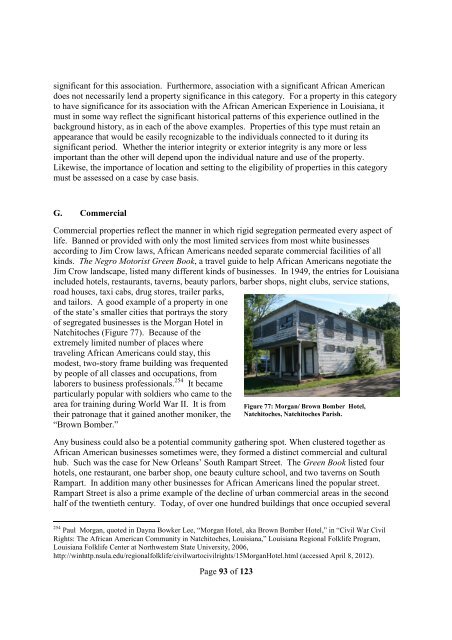The African American Experience in Louisiana
The_African_American_Experience_in_Louisiana
The_African_American_Experience_in_Louisiana
- No tags were found...
You also want an ePaper? Increase the reach of your titles
YUMPU automatically turns print PDFs into web optimized ePapers that Google loves.
significant for this association. Furthermore, association with a significant <strong>African</strong> <strong>American</strong><br />
does not necessarily lend a property significance <strong>in</strong> this category. For a property <strong>in</strong> this category<br />
to have significance for its association with the <strong>African</strong> <strong>American</strong> <strong>Experience</strong> <strong>in</strong> <strong>Louisiana</strong>, it<br />
must <strong>in</strong> some way reflect the significant historical patterns of this experience outl<strong>in</strong>ed <strong>in</strong> the<br />
background history, as <strong>in</strong> each of the above examples. Properties of this type must reta<strong>in</strong> an<br />
appearance that would be easily recognizable to the <strong>in</strong>dividuals connected to it dur<strong>in</strong>g its<br />
significant period. Whether the <strong>in</strong>terior <strong>in</strong>tegrity or exterior <strong>in</strong>tegrity is any more or less<br />
important than the other will depend upon the <strong>in</strong>dividual nature and use of the property.<br />
Likewise, the importance of location and sett<strong>in</strong>g to the eligibility of properties <strong>in</strong> this category<br />
must be assessed on a case by case basis.<br />
G. Commercial<br />
Commercial properties reflect the manner <strong>in</strong> which rigid segregation permeated every aspect of<br />
life. Banned or provided with only the most limited services from most white bus<strong>in</strong>esses<br />
accord<strong>in</strong>g to Jim Crow laws, <strong>African</strong> <strong>American</strong>s needed separate commercial facilities of all<br />
k<strong>in</strong>ds. <strong>The</strong> Negro Motorist Green Book, a travel guide to help <strong>African</strong> <strong>American</strong>s negotiate the<br />
Jim Crow landscape, listed many different k<strong>in</strong>ds of bus<strong>in</strong>esses. In 1949, the entries for <strong>Louisiana</strong><br />
<strong>in</strong>cluded hotels, restaurants, taverns, beauty parlors, barber shops, night clubs, service stations,<br />
road houses, taxi cabs, drug stores, trailer parks,<br />
and tailors. A good example of a property <strong>in</strong> one<br />
of the state’s smaller cities that portrays the story<br />
of segregated bus<strong>in</strong>esses is the Morgan Hotel <strong>in</strong><br />
Natchitoches (Figure 77). Because of the<br />
extremely limited number of places where<br />
travel<strong>in</strong>g <strong>African</strong> <strong>American</strong>s could stay, this<br />
modest, two-story frame build<strong>in</strong>g was frequented<br />
by people of all classes and occupations, from<br />
laborers to bus<strong>in</strong>ess professionals. 254 It became<br />
particularly popular with soldiers who came to the<br />
area for tra<strong>in</strong><strong>in</strong>g dur<strong>in</strong>g World War II. It is from<br />
their patronage that it ga<strong>in</strong>ed another moniker, the<br />
“Brown Bomber.”<br />
Figure 77: Morgan/ Brown Bomber Hotel,<br />
Natchitoches, Natchitoches Parish.<br />
Any bus<strong>in</strong>ess could also be a potential community gather<strong>in</strong>g spot. When clustered together as<br />
<strong>African</strong> <strong>American</strong> bus<strong>in</strong>esses sometimes were, they formed a dist<strong>in</strong>ct commercial and cultural<br />
hub. Such was the case for New Orleans’ South Rampart Street. <strong>The</strong> Green Book listed four<br />
hotels, one restaurant, one barber shop, one beauty culture school, and two taverns on South<br />
Rampart. In addition many other bus<strong>in</strong>esses for <strong>African</strong> <strong>American</strong>s l<strong>in</strong>ed the popular street.<br />
Rampart Street is also a prime example of the decl<strong>in</strong>e of urban commercial areas <strong>in</strong> the second<br />
half of the twentieth century. Today, of over one hundred build<strong>in</strong>gs that once occupied several<br />
254 Paul Morgan, quoted <strong>in</strong> Dayna Bowker Lee, “Morgan Hotel, aka Brown Bomber Hotel,” <strong>in</strong> “Civil War Civil<br />
Rights: <strong>The</strong> <strong>African</strong> <strong>American</strong> Community <strong>in</strong> Natchitoches, <strong>Louisiana</strong>,” <strong>Louisiana</strong> Regional Folklife Program,<br />
<strong>Louisiana</strong> Folklife Center at Northwestern State University, 2006,<br />
http://w<strong>in</strong>http.nsula.edu/regionalfolklife/civilwartocivilrights/15MorganHotel.html (accessed April 8, 2012).<br />
Page 93 of 123


